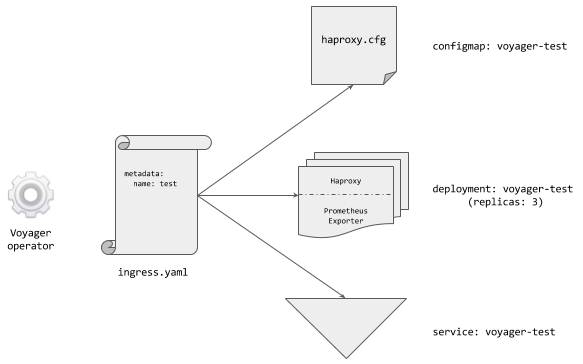Voyager
Voyager is a HAProxy backed secure L7 and L4 ingress controller for Kubernetes developed by AppsCode. This can be used with any Kubernetes cloud providers including aws, gce, gke, azure, acs. This can also be used with bare metal Kubernetes clusters.
Ingress
Voyager provides L7 and L4 loadbalancing using Kubernetes standard Ingress resource. This is built on top of the HAProxy to support high availability, sticky sessions, name and path-based virtual hosting among other features. The following diagram shows how voyager operator works. Voyager also provides a custom Ingress resource under voyager.appscode.com api group that extends the functionality of standard Ingress in a Kubernetes native way.

The above diagram shows how the Voyager operator works. When Voyager is installed in a Kubernetes cluster, a pod named voyager-operator-*** starts running in voyager namespace by default. This operator pod watches for Kubernetes Ingress resources and Voyager’s own Ingress CRD. When an Ingress object is created, Voyager operator creates 3 Kubernetes resources in the same namespace of the Ingress:
a Configmap named
voyager-${ingress-name}: This contains the auto generated HAProxy configuration underhaproxy.cfgkey.a Deployment named
voyager-${ingress-name}: This runs HAProxy pods that mounts the above configmap. Each pod has one container for HAProxy. This container also includes some additional binary to reload HAProxy when the respective configmap updates. This also includes logic for mounting and updating SSL secrets referenced in the corresponding Ingress resource. HAProxy pods can also contain a side-car container for exporting Prometheus ready metrics, if enabled.a Service named
voyager-${ingress-name}: This Kubernetes Service exposes the above HAProxy pods to the internet. The type of Service can be configured by user viaingress.appscode.com/typeannotation on the Ingress.a Service named
voyager-${ingress-name}-stats: This Kubernetes Service is used to expose Prometheus ready metrics for HAProxy pods. This service is always of typeClusterIPand only created if stats are enabled.
Certificate
Voyager can automagically provision and refresh SSL certificates issued from Let’s Encrypt using a custom Kubernetes Certificate resource.
- Provision free TLS certificates from Let’s Encrypt,
- Manage issued certificates using a Kubernetes Third Party Resource,
- Domain validation using ACME dns-01 challenges,
- Support for multiple DNS providers,
- Auto Renew Certificates,
- Use issued Certificates with Ingress to Secure Communications.
FAQ
How do I run Voyager with other Ingress controllers in the same cluster?
Yes, Voyager can be used to manager Ingress objects alongside with other ingress controller. Voyager comes with its own CRD called Ingress under api version voyager.appscode.com/v1 . This CRD is not recognized by other ingress controllers that works with the Kubernetes official Ingress object under networking.k8s.io/v1 api version.
By default, Voyager will also manage Kubernetes Ingress objects under networking.k8s.io/v1 api version. Voyager can be configured to only handle default Kubernetes Ingress objects with ingress.class voyager . To do that, pass the flag --ingress-class=voyager in operator pod. After that
annotations:
kubernetes.io/ingress.class=voyager
Why does Voyager creates separate HAProxy pods for each Ingress?
Various Ingress controller behave differently regarding whether separate Ingress object will result in separate LoadBalancer.
- nginx: Nginx controller seem to combine Ingress objects into one and expose via same Nginx instance.
- gce: A separate GCE L7 is created for each Ingress object.
- Voyager: A separate HAProxy deployment is created for each Ingress.
There is not a clear indication what is the intended behavior from https://kubernetes.io/docs/concepts/services-networking/ingress/ . Reasons why we think one LB (GCE L7 / nginx / haproxy) per Ingress is a better choice:
This gives users choice/control whether they want to serve all service using the same IP or use separate IP. In voyager, to serve using same LB, users need to put them in the same Ingress.
I think ux is clearer with this mode. If user don’t have access to other namespaces, they may not know what else is going on.
Voyager supports TCP. If 2 separate backend wants to use the same port, they need separate LB IP. Also, since all TCP services served via same LB is in the same YAML, it makes it easy to see what other ports are in use.
In Voyager, the order of paths for same host is important. We maintain this order in generated HAProxy config. If the Ingresses are auto merged, user loses this control. This might be ok, since paths are matched as the url prefix. But will not work, if other options are used.
Users can spread services across LB pods. If used with HPA, users can only scale up HAProxy deployments that they want.
We do soft reload HAProxy. This gives better isolation.









